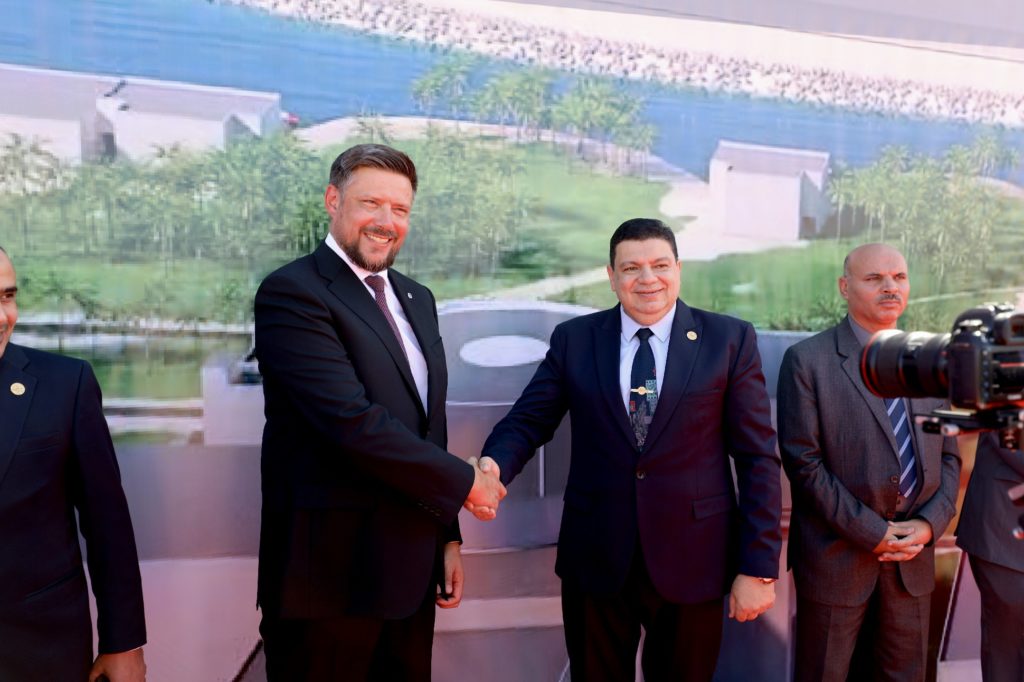
Maximum Safety
back to contentsThe latest important events at the El Dabaa NPP construction site are centered around molten core catchers, also known as melt traps. The installation of this device has been recently completed at El Dabaa Unit 3, while components of the core catcher for Unit 4 were delivered to the site in early November.
The ship carrying core catcher components left the Russian port of Novorossiysk in October. Their total weight exceeded 700 tonnes, with the catcher body alone weighing 155 tonnes. The cargo was delivered to Egypt ahead of schedule.
“We installed core catchers at Units 1 and 2 in 2023, and another one at Unit 3 in 2024. If we manage to do the same at Unit 4 this year, this will prove our process is resilient, with two such devices installed each year. The construction of VVER 1200 reactor units is a well-established process that has become routine for Rosatom. We have transitioned from one-off projects to a commercial, work-flow approach to construction,” said Alexey Kononenko, Vice President of ASE and Director of El Dabaa Construction Project.
Installation of the core catcher at Unit 4 is scheduled to begin by the end of the year.
“As soon as the melt trap is installed at Unit 4, each of the power units at El Dabaa NPP will be equipped with this safety device. This will mean that another important milestone has been passed on the way to the Egyptian dream of a nuclear power plant thanks to God’s grace and joint efforts of the Egyptian and Russian teams,” said Amged El-Wakeel, Chairman of the Board of the Egyptian Nuclear Power Plants Authority (NPPA).
The core catcher is a pioneering safety device designed by Russian nuclear engineers. This cone-shaped vessel made of high temperature resistant steel is installed at the bottom of the concrete pit, right under the reactor, and filled with the so-called ‘sacrificial material’. In case of a core meltdown, the core catcher reliably retains corium fragments and keeps them inside the reactor containment. However, the probability of such accidents is extremely low and, according to expert estimates, stands at one in a million.
Core catchers are included in the design of every nuclear power plant with VVER 1200 reactors. Foreign reactor designs, even those belonging to Generation III+, do not have such safety devices.

Installation of the core catcher at El Dabaa Unit 3 started in early October. These works were carried out by a 10 strong team using a heavy Zoomlion ZCC 32000 crane with a lifting capacity of 2,000 tonnes.
“The installation of the core catcher at Unit 3 started on time, but this would not have been possible without all-round cooperation between the Egyptian customer and the general contractor. I would like to express my deep gratitude to everyone who made efforts to achieve this milestone of our joint project,” Alexey Kononenko said.
Both in Egypt and Turkey
Another project similar to El Dabaa in scale is the Akkuyu Nuclear Power Plant being built by Rosatom in Turkey. All of its four VVER 1200 reactor units are simultaneously under construction.
Full-scale pre-commissioning operations are underway at Akkuyu Unit 1. Its systems and equipment are being gradually made ready for operation and checked thoroughly for compliance with the design parameters. In early November, workers finished concreting the outer containment dome on the reactor building of the first power unit. The outer containment shell is an essential safety element of each reactor. Its reinforced concrete structure will safely protect the reactor from external impacts.
In October, the second low-pressure rotor was assembled and placed into the turbine stator in the turbine building of Unit 1. The turbine will soon be ready for the jacking gear installation and a subsequent series of pre-commissioning tests.
Construction and installation works at the other units are continuing as scheduled. Earlier this autumn, two emergency core cooling system (ECCS) tanks were installed in their design position at Akkuyu Unit 2. The ECCS tanks contain an emergency stock of aqueous boric acid solution. Being a neutron absorber, it is used for flooding the reactor core, thus ensuring safety in an emergency situation.
In early autumn, workers concreted a foundation slab for the turbine of Unit 3. It is designed to withstand and evenly distribute heavy loads caused by the turbine in operation.




